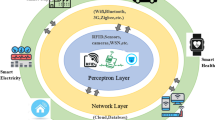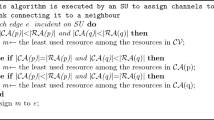Abstract
The false blocking problem is induced by the traditional IEEE 802.11 Request-To-Send/Clear-To-Send (RTS/CTS) handshaking in wireless ad hoc networks such as the emerging Device-to-Device (D2D) ad hoc network. An RTS overhearing node is falsely deferred (blocked) when the RTS/CTS handshaking is unsuccessful. The deferred node does not reply to any other incoming packets during its deferral, resulting in the propagation of false blocking. To mitigate the false blocking problem, various false blocking mitigation schemes were proposed. In this paper, an analytical model based on the Markov chain is developed to mathematically analyse and assess the effectiveness of the false blocking mitigation schemes. The analytical model can be applied to the various medium access control (MAC) protocols in the wireless ad hoc networks. Three mitigation schemes i.e. Ready-to-Send Blocking Notification (RSBN), Request-to-Send Validation (RTS-V), and traditional 802.11 schemes are studied. The results from both the analytical evaluation and simulation evaluation are closely matched. This shows the analytical model is able to accurately represent the behaviour and also provide the performance of various schemes in mitigating the false blocking problem. The analytical model is general and flexible enough that it can be adapted to model any existing and future false blocking mitigation schemes.













Similar content being viewed by others
References
Funai C, Tapparello C, Heinzelman W (2017) Enabling multi-hop ad hoc networks through WiFi Direct multi-group networking. International Conference on Computing, Networking and Communications (ICNC):491–497. https://doi.org/10.1109/ICCNC.2017.7876178
Reina DG, Toral SL, Johnson P, Barrero F (2015) A survey on probabilistic broadcast schemes for wireless ad hoc networks. Ad Hoc Netw 25:263–292. https://doi.org/10.1016/j.adhoc.2014.10.001
Dang DNM, Nguyen V, Le HT, Hong CS, Choe J (2016) An efficient multi-channel MAC protocol for wireless ad hoc networks. Ad Hoc Netw 44:46–57. https://doi.org/10.1016/j.adhoc.2016.02.013
Son D, Huh S, Lee T, Kwak J (2020) Internet of things system technologies based on quality of experience. Peer-to-Peer Networking and Applications 13(2):475–488. https://doi.org/10.1007/s12083-019-00727-1
Li S, Da Xu L, Zhao S (2018) 5G internet of things: a survey. J Ind Inf Integr 10:1–9. https://doi.org/10.1016/j.jii.2018.01.005
Thomas A, Raja G (2019) FINDER: A D2D based critical communications framework for disaster management in 5G. Peer-to-Peer Networking and Applications 12(4):912–923. https://doi.org/10.1007/s12083-018-0689-2
Hayat O, Ngah R, Zahedi Y (2019) In-Band Device to Device (D2D) Communication and Device Discovery: A Survey. Wireless Personal Communications:1–22. https://doi.org/10.1007/s11277-019-06173-9
IEEE 802.11. Wireless LAN Media Access Control (MAC) and Physical Layer (PHY) Specification (2017)
Wei Z, Sun Y, Ji Y (2017) Collision analysis of CSMA/CA based MAC protocol for duty cycled WBANs. Wireless Networks 23(5):1429–1447. https://doi.org/10.1007/s11276-016-1230-2
Ahmed N, Rahman H, Hussain MI (2016) A comparison of 802.11ah and 802.15. 4 for IoT. ICT Express 2(3):100–102. https://doi.org/10.1016/j.icte.2016.07.003
Sangeetha U, Babu A (2019) Performance analysis of IEEE 802.11 ah wireless local area network under the restricted access window-based mechanism. International Journal of Communication Systems 32(4). https://doi.org/10.1002/dac.3888
Ismaiel B, Abolhasan M, Smith D et al (2017) Scalable MAC protocol for D2D communication for future 5G networks. IEEE Annual Consumer Communications & Networking Conference (CCNC):542–547. https://doi.org/10.1109/CCNC.2017.7983165
Maksymyuk T, Brych M, Klymash M et al (2017) Cooperative channels allocation in unlicensed spectrum for D2D assisted 5G cellular network. Advanced Information and Communication Technologies (AICT):197–200. https://doi.org/10.1109/AIACT.2017.8020098
Fafoutis X, Di Mauro A, Vithanage MD, Dragoni N (2015) Receiver-initiated medium access control protocols for wireless sensor networks. Comput Netw 76:55–74. https://doi.org/10.1016/j.comnet.2014.11.002
Yao J, Lou W, Yang C, Wu K (2018) Efficient interference-aware power control for wireless networks. Comput Netw 136:68–79. https://doi.org/10.1016/j.comnet.2018.02.017
Chakraborty S, Nandi S, Chattopadhyay S (2015) Alleviating hidden and exposed nodes in high-throughput wireless mesh networks. IEEE Trans Wirel Commun 15(2):928–937. https://doi.org/10.1109/TWC.2015.2480398
Ray S, Carruthers J, Starobinski D (2003) RTS/CTS-induced congestion in ad hoc wireless LANs. In Proceedings of IEEE Wireless Communications and Networking Conference 3:1516–1521. https://doi.org/10.1109/WCNC.2003.1200611
Ray S, Starobinski D (2007) On false blocking in RTS/CTS-based multihop wireless networks. IEEE Transactions of Vehicular Technology 56(2):849–862. https://doi.org/10.1109/TVT.2007.891476
Chong WK, Drieberg M, Jeoti V (2018) Mitigating false blocking problem in wireless ad hoc networks. Telecommun Syst 67(1):31–46. https://doi.org/10.1007/s11235-017-0314-3
Hossain MA, Sarkar NI, Gutierrez J, Liu W (2017) Performance study of block ACK and reverse direction in IEEE 802.11n using a Markov chain model. Journal of Network and Computer Applications 78:170–179. https://doi.org/10.1016/j.jnca.2016.11.029
Chandra K, Prasad RV, Niemegeers I (2017) Performance analysis of IEEE 802.11ad MAC protocol. IEEE communications letters 21(7):1513–1516. https://doi.org/10.1109/LCOMM.2017.2677924
Yazid M, Aïssani D, Bouallouche-Medjkoune L, Amrouche N, Bakli K (2015) Modeling and enhancement of the IEEE 802.11 RTS/CTS scheme in an error-prone channel. Formal Aspects of Computing 27(1):33–52. https://doi.org/10.1007/s00165-014-0300-4
Weng CE, Chen HC (2016) The performance evaluation of IEEE 802.11 DCF using Markov chain model for wireless LANs. Computer Standards & Interfaces 44:144–149. https://doi.org/10.1016/j.csi.2015.09.002
Sanada K, Komuro N, Sekiya H (2015) End-to-end throughput and delay analysis for IEEE 802.11 string topology multi-hop network using Markov-chain model. Personal, Indoor, and Mobile Radio Communications (PIMRC):1697–1701. https://doi.org/10.1109/PIMRC.2015.7343572
Karabulut MA, Shah AS, Ilhan H (2017) Performance modeling and analysis of the IEEE 802.11 DCF for VANETs. Ultra Modern Telecommunications and Control Systems and Workshops (ICUMT):346–351. https://doi.org/10.1109/ICUMT.2017.8255147
Joon R, Singh RP (2015) Modelling of IEEE 802.11 DCF in the Presence of Hidden Nodes. International Journal of Wireless and Mobile Computing 9(1):70–77. https://doi.org/10.1504/IJWMC.2015.071674
Rathee P, Singh R, Kumar S (2016) Performance Analysis of IEEE 802.11p in the Presence of Hidden Terminals. Wireless Personal Communications 89(1):61–78. https://doi.org/10.1007/s11277-016-3252-6
Doost-Mohammady R, Naderi MY, Chowdhury KR (2015) Performance analysis of CSMA/CA based medium access in full duplex wireless communications. IEEE Trans Mob Comput 15(6):1457–1470. https://doi.org/10.1109/TMC.2015.2462832
Hajlaoui N, Jabri I, Jemaa MB (2018) An accurate two dimensional Markov chain model for IEEE 802.11 n DCF. Wireless Networks 24(4):1019–1031. https://doi.org/10.1007/s11276-016-1383-z
Bhattacharya A, Kumar A (2017) Analytical Modeling of IEEE 802.11-Type CSMA/CA Networks with Short Term Unfairness. IEEE/ACM Transactions on Networking (TON) 25(6):3455–3472. https://doi.org/10.1109/TNET.2017.2747406
Garrido P, Lucani DE, Agüero R (2017) Markov chain model for the decoding probability of sparse network coding. IEEE Trans Commun 65(4):1675–1685. https://doi.org/10.1109/TCOMM.2017.2657621
Deng X, He T, He L, Gui J, Peng Q (2017) Performance analysis for IEEE 802.11s wireless mesh network in smart grid. Wireless Personal Communications 96(1):1537–1555. https://doi.org/10.1007/s11277-017-4255-7
MathWorks – MATLAB [Online]. ww2.mathworks.cn/en/products/matlab.html (2020). Accessed December 2020
OMNeT++ Discrete Event Simulator [Online]. omnetpp.org (2020). Accessed December 2020
NS-3 Network Simulator [Online]. nsnam.org (2021). Accessed January 2021
Manzoor S, Yin Y, Gao Y, Hei X, Cheng W (2020) A Systematic Study of IEEE 802.11 DCF Network Optimization From Theory to Testbed. IEEE Access 8:154114–154132. https://doi.org/10.1109/ACCESS.2020.3018088
Rebeca Modeling Language [Online]. rebeca-lang.org (2020). Accessed December 2020
Yousefi B, Ghassemi F, Khosravi R (2017) Modeling and efficient verification of wireless ad hoc networks. Form Asp Comput 29(6):1051–1086. https://doi.org/10.1007/s00165-017-0429-z
Jaghoori M, Movaghar A, Sirjani M (2006) The Model Checking Engine of Rebeca. ACM SAC (6). https://doi.org/10.1145/1141277.1141704
Author information
Authors and Affiliations
Corresponding author
Additional information
Publisher’s note
Springer Nature remains neutral with regard to jurisdictional claims in published maps and institutional affiliations.
Rights and permissions
About this article
Cite this article
Chong, W.K., Drieberg, M., Jeoti, V. et al. Analytical modelling of false blocking problem in wireless ad hoc networks. Peer-to-Peer Netw. Appl. 15, 221–245 (2022). https://doi.org/10.1007/s12083-021-01156-9
Received:
Accepted:
Published:
Issue Date:
DOI: https://doi.org/10.1007/s12083-021-01156-9




